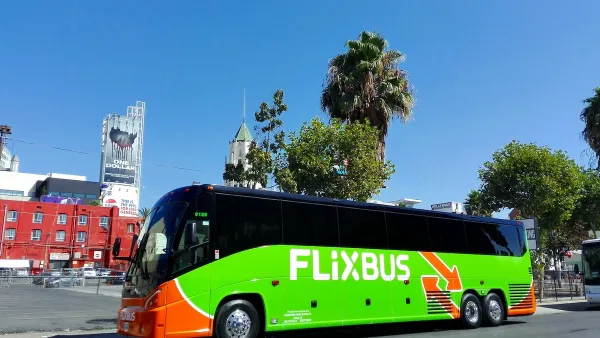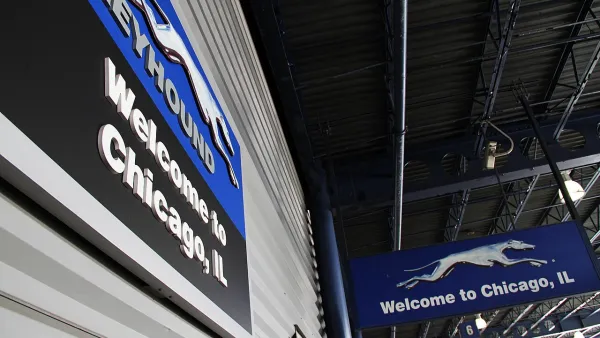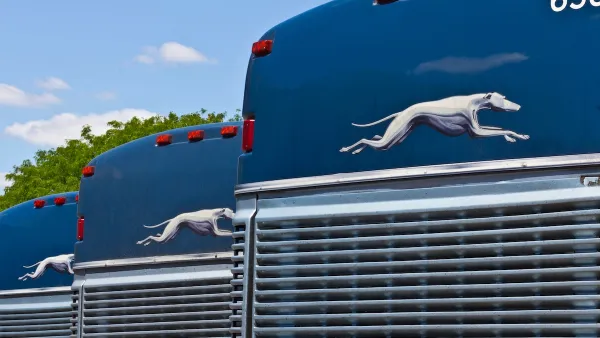As I began to type this, I was on a Greyhound bus somewhere in southern Ontario, on the first leg of my return from Toronto (where I have spent the past year getting an extra degree) to the United States. As I type, it occurs to me to ask myself: what are the interests of the long-distance bus rider? Are they the same as users of other forms of public transit, or closer to those of drivers and truckers? My short answer to these questions is: a little of both.
As
I began to type this, I was on a Greyhound bus somewhere in southern Ontario,
on the first leg of my return from Toronto (where I have spent the past
year getting an extra
degree) to the United States.
As I type, it occurs to me to ask
myself: what are the interests of the long-distance bus rider? Are
they the same as users of other forms of
public transit, or closer to those of drivers and truckers? My short
answer to these questions is: a little of both.
First
of all, a bus rider needs good roads: smooth roads that enable him/her
to read
or type without being jolted by stomach-churning bumps. In
this respect, a bus rider is like a
motorist: motorists also value good roads rather than pothole-filled
obstacle
courses.
And certainly a bus
rider places some value on lack of
congestion, though probably less than a motorist. In a bus, I don't
expect a
total free flow of traffic, but I do mind congestion sufficiently severe
to
create enormous delays. Although all bus riders
value on-time performance, I think this is probably somewhat more true
for
long-distance bus riders than for riders of municipal buses, since the
former
group is more likely to be stuck on interstate highways where there is
no escape
from congestion. (By contrast, if a bus on a downtown street is moving
too
slowly for your taste, you might be able to get off the bus and start walking to
your
destination).*
But in other respects, long-distance
bus riders and municipal bus riders are like pedestrians and users of
rail
transit. For example, even intercity bus riders value public transit, so that once
they
get in their destination city they can reach a wide variety of destinations within the city.
And ideally, the bus station should be in a walkable area well served by public transit. When I ride a long-distance
bus, I want my bus station to be in a busy neighbourhood where I can
walk to
something interesting if I have some spare time. For
example, Toronto's bus station is quite centrally
located, which means I can walk to an enormous variety of destinations.
But in other cities, this is not the case. For example, I was recently
on a bus that stopped at the South Bend, Indiana, airport, which
appeared to be near absolutely nothing. (After checking walkscore.com, I
found that its Walkscore was 11). When I visited Chattanooga some years ago, I noticed that its bus station (also near the airport) is a few blocks away from not only the nearest city bus, but even the nearest sidewalk.
Other bus stations are in truly
scary neighborhoods; St. Louis's bus station appeared to be in one of
the city's large stock of deserted areas. In my experience, this is a
"smart growth vs. sprawl" issue: the most transit and
pedestrian-oriented cities tend to have bus stations closer to downtown,
while declining or sprawling cities tend to have bus stations in less
impressive places. **
*Depending
on how
able-bodied you are, the degree of hurry you are in, and numerous other
variables.
**However, there are plenty of exceptions to this
generalization. For example, Jacksonville's bus station is pretty close to the heart of downtown.

Analysis: Cybertruck Fatality Rate Far Exceeds That of Ford Pinto
The Tesla Cybertruck was recalled seven times last year.

National Parks Layoffs Will Cause Communities to Lose Billions
Thousands of essential park workers were laid off this week, just before the busy spring break season.

Retro-silient?: America’s First “Eco-burb,” The Woodlands Turns 50
A master-planned community north of Houston offers lessons on green infrastructure and resilient design, but falls short of its founder’s lofty affordability and walkability goals.

Test News Post 1
This is a summary

Analysis: Cybertruck Fatality Rate Far Exceeds That of Ford Pinto
The Tesla Cybertruck was recalled seven times last year.

Test News Headline 46
Test for the image on the front page.
Urban Design for Planners 1: Software Tools
This six-course series explores essential urban design concepts using open source software and equips planners with the tools they need to participate fully in the urban design process.
Planning for Universal Design
Learn the tools for implementing Universal Design in planning regulations.
EMC Planning Group, Inc.
Planetizen
Planetizen
Mpact (formerly Rail~Volution)
Great Falls Development Authority, Inc.
HUDs Office of Policy Development and Research
NYU Wagner Graduate School of Public Service





























